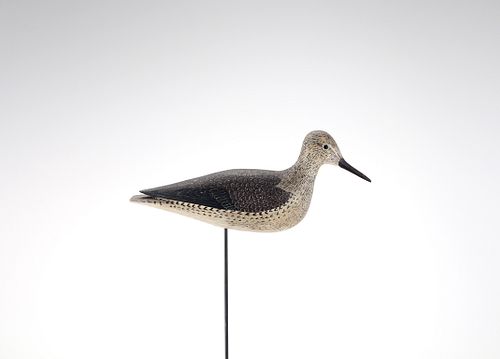Nina Fletcher Little Wilson Yellowlegs Decoy, Thomas C. Wilson (1865-1936)
About Seller
20 Winter Street
Pembroke, MA 02359
United States
Founded in 2005, Copley Fine Art Auctions is a boutique auction house specializing in antique decoys and American, sporting, and wildlife paintings. Over the course of the last two decades, the firm has set auction records for not only individual decoy makers, but also entire carving regions. Copley...Read more
Two ways to bid:
- Leave a max absentee bid and the platform will bid on your behalf up to your maximum bid during the live auction.
- Bid live during the auction and your bids will be submitted real-time to the auctioneer.
Bid Increments
| Price | Bid Increment |
|---|---|
| $0 | $50 |
| $1,000 | $100 |
| $2,500 | $250 |
| $5,000 | $500 |
| $10,000 | $1,000 |
| $25,000 | $2,500 |
| $50,000 | $5,000 |
About Auction
Jul 9, 2021
Lots 1-246 Copley Fine Art Auctions cinnie@copleyart.com
- Lot Description
Nina Fletcher Little Wilson Yellowlegs
Thomas C. Wilson (1865-1936)
Ipswich, MA, c. 1890
12 1/2 in. long
This brilliant yellowlegs was discovered by Nina Fletcher Little in 1951 as part of a group of a dozen waterfowl and shorebird decoys. The vast majority of Little's discovery was put on exhibition in "Tollers and Tattlers," a three-year exhibition at the Peabody Museum of Salem, Massachusetts, October 1989-1992. Examples ended up in distinguished collections, including those of Winsor White and Donal C. O'Brien Jr.
The son of a shipbuilder, Wilson was a market gunner early in his life. In 1910 he was a state officer for the Massachusetts Department of Fish and Game. Later in life, he moved to Portsmouth, New Hampshire, where he managed a gunning camp and guided other sportsmen. As a steadfast hunter and observer of shorebirds and ducks, Wilson's ability to capture species' attitudes and nuances was quite astute. This grand snipe shows the intricate stipple and loop feather paint that Wilson is known for. The work of Wilson is closely related to that of Fred Nichols (1854-1924), another of the North Shore's most talented makers. This is one of the finest Wilson decoys to ever be offered at auction.
The underside of the tail retains Little's early typed collector's note.
Excellent original paint with minimal wear and a tight age line along the left side.
Provenance: Nina Fletcher Little Collection, acquired 1951
The Johnson Collection
Literature: Hal Sorenson, "Decoy Collector's Guide," Burlington, IA, 1965, p. 12, rigmate pictured on the wall in a photograph of Winsor White's home in Duxbury, Massachusetts. Decoy Magazine, Lewes, DE, September/October 1989, cover and pp. 21-27, rigmates illustrated and discussed. Copley Fine Art Auctions, "The Sporting Sale 2010," Plymouth, MA, July 22-23, 2010, lot 665, rigmate illustrated.Please email condition report requests to colin@copleyart.com. Any condition statement given is a courtesy to customers, Copley will not be held responsible for any errors or omissions. The absence of a condition statement does not imply that the lot is in perfect condition.Condition
- Shipping Info
-
Copley Fine Art Auctions does not handle the shipping of any items. Shipping is the sole responsibility of the buyer. Once your payment has cleared, and we have received your authorized shipping release form items may be released for shipment. Copley Fine Art Auctions, LLC shall have no liability for any loss or damage to such items. Buyers should allow up to four weeks for shipment. Please be aware that internet bidders may NOT not pick up their items at the sale. Items will be available for pick up by appointment or by shippers five days after the sale.
-
- Buyer's Premium



 EUR
EUR CAD
CAD AUD
AUD GBP
GBP MXN
MXN HKD
HKD CNY
CNY MYR
MYR SEK
SEK SGD
SGD CHF
CHF THB
THB
















